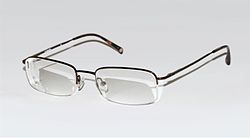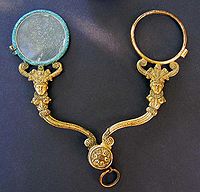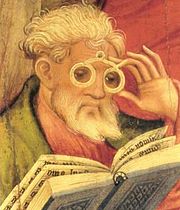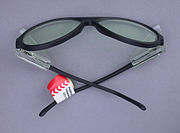
Glasses
Did you know...
SOS believes education gives a better chance in life to children in the developing world too. SOS Children has looked after children in Africa for forty years. Can you help their work in Africa?
Glasses – also called eyeglasses (formal), spectacles, or specs (informal) – are frames bearing lenses worn in front of the eyes, normally for vision correction or eye protection. Safety glasses are a kind of eye protection against flying debris or against visible and near visible light or radiation. Sunglasses allow better vision in bright daylight, and may protect against damage from high levels of ultraviolet light. Other types of glasses may be used for viewing visual information (such as stereoscopy) or simply just for aesthetic or fashion values.
Historical types of glasses include the pince-nez, monocle, lorgnette, and scissor or scissors-glasses.
Modern glasses are typically supported by pads on the bridge of the nose and by temple arms (sides) placed over the ears. CR-39 lenses are the most common plastic lenses due to their low weight, high scratch resistance, low dispersion, and low transparency to ultraviolet and infrared radiation. Polycarbonate and Trivex lenses are the lightest and most shatter-resistant, making them the best for impact protection.
An unpopular aspect of glasses is their inconvenience. Even through the creation of light frames such as those made of titanium, very flexible frames, and new lens materials and optical coatings, glasses can still cause problems during rigorous sports. Visibility can be significantly reduced by becoming greasy, trapping vapour when eating hot food, swimming, walking in rain or rapid temperature changes (such as walking into a warm building from cold temperatures outside). Scraping, fracturing, or breakage of the lenses require time-consuming and costly professional repair, though modern plastic lenses are almost indestructible and very scratch-resistant.
History of eyeglasses
Precursors
The earliest historical reference to magnification dates back to ancient Egyptian hieroglyphs in the 5th century BC, which depict "simple glass meniscal lenses". The earliest written record of magnification dates back to the 1st century AD, when Seneca the Younger, a tutor of Emperor Nero of Rome, wrote: "Letters, however small and indistinct, are seen enlarged and more clearly through a globe or glass filled with water". Nero (reigned 54–68 AD) is also said to have watched the gladiatorial games using an emerald as a corrective lens.
Corrective lenses were said to be used by Abbas Ibn Firnas in the 9th century, who had devised a way to produce very clear glass. These glasses could be shaped and polished into round rocks used for viewing and were known as reading stones. The earliest evidence of "a magnifying device, a convex lens forming a magnified image," dates back to the Book of Optics published by Alhazen in 1021. Its translation into Latin from Arabic in the 12th century was instrumental to the invention of eyeglasses in 13th century Italy.
Englishman Robert Grosseteste's treatise De iride ("On the Rainbow"), written between 1220 and 1235, mentions using optics to "read the smallest letters at incredible distances". A few years later, Roger Bacon is also known to have written on the magnifying properties of lenses in 1262.
Reportedly, spectacles were in use in China by the rich and elderly at the time of Marco Polo's arrival in 1270 or 1271, although the Chinese credit their invention to Arabia in the 11th century.
Sunglasses, in the form of flat panes of smoky quartz, protected the eyes from glare and were used in China in the 12th century or possibly earlier. Similarly, the Inuit have used snow goggles for eye protection. However, they did not offer any corrective benefits and the use by historians of the term "sunglasses" is anachronistic before the twentieth century.
Invention of eyeglasses
Many theories abound for who should be credited for the invention of traditional eyeglasses. Despite evidence of spectacles in China in 1270, and Chinese claims of themselves importing spectacle technology from the Middle East in the 11th century, some people theorise that spectacles were first invented between 1280 and 1300 in Italy. Some also theorise that the first European inventor of spectacles was Salvino D'Armate.
In 1676, Francesco Redi, a professor of medicine at the University of Pisa, wrote that he possessed a 1289 manuscript whose author complains that he would be unable to read or write were it not for the recent invention of glasses. He also produced a record of a sermon given in 1305, in which the speaker, a Dominican friar named Fra Giordano da Rivalto, remarked that glasses had been invented less than twenty years previously, and that he had met the inventor. Based on this evidence, Redi credited another Dominican friar, Fra Alessandro da Spina of Pisa, with the re-invention of glasses after their original inventor kept them a secret, a claim contained in da Spina's obituary record. However, Spina most likely learned to make spectacles after seeing them made by another individual, a talent for which he was known at the time.
Another potential inventor is Salvino D'Armate, who is credited with inventing the first wearable eye glasses on 16 September 1284 in Italy. In a 1684 history of Florence, Leopoldo del Migliore wrote that the church of Santa Maria Maggiore contained a memorial honoring D'Armati with the inscription: Here lies Salvino degl' Armati, son of Armato of Florence, inventor of eyeglasses. May God forgive his sins. A.D. 1317. The church has been rebuilt several times since the 13th century, however, and this tomb no longer exists, so the claim cannot be verified.
The earliest pictorial evidence for the use of eyeglasses is Tommaso da Modena's 1352 portrait of the cardinal Hugh de Provence reading in a scriptorium. Another early example would be a depiction of eyeglasses found north of the Alps in an altarpiece of the church of Bad Wildungen, Germany, in 1403.
These early spectacles had convex lenses that could correct both hyperopia (farsightedness), and the presbyopia that commonly develops as a symptom of aging. Nicholas of Cusa is believed to have discovered the benefits of concave lens in the treatment of myopia (nearsightedness). However, it was not until 1604 that Johannes Kepler published in his treatise on optics and astronomy, the first correct explanation as to why convex and concave lenses could correct presbyopia and myopia.
Later developments
The American scientist Benjamin Franklin, who suffered from both myopia and presbyopia, adopted bifocals in 1784 to avoid having to regularly switch between two pairs of glasses although the claim that he actually invented them is disputed.
The first lenses for correcting astigmatism were constructed by the British astronomer George Airy in 1825.
Over time, the construction of spectacle frames also evolved. Early eyepieces were designed to be either held in place by hand or by exerting pressure on the nose (pince-nez). Girolamo Savonarola suggested that eyepieces could be held in place by a ribbon passed over the wearer's head, this in turn secured by the weight of a hat. The modern style of glasses, held by temples passing over the ears, was developed some time before 1727, possibly by the British optician Edward Scarlett. These designs were not immediately successful, however, and various styles with attached handles such as " scissors-glasses" and lorgnettes were also fashionable from the second half of the 18th century and into the early 19th century.
In the early 20th century, Moritz von Rohr at Zeiss (with the assistance of H. Boegehold and A. Sonnefeld), developed the Zeiss Punktal spherical point-focus lenses that dominated the eyeglass lens field for many years.
Despite the increasing popularity of contact lenses and laser corrective eye surgery, glasses remain very common, as their technology has improved. For instance, it is now possible to purchase frames made of special memory metal alloys that return to their correct shape after being bent. Other frames have spring-loaded hinges. Either of these designs offers dramatically better ability to withstand the stresses of daily wear and the occasional accident. Modern frames are also often made from strong, light-weight materials such as titanium alloys, which were not available in the earlier times.
Types
Corrective
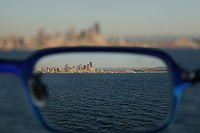
Corrective lenses are used to correct refractive errors of the eye by modifying the effective focal length of the lens in order to alleviate the effects of conditions such as nearsightedness (myopia), farsightedness (hyperopia) or astigmatism. Another common condition in older patients is presbyopia which is caused by the eye's crystalline lens losing elasticity, progressively reducing the ability of the lens to accommodate (i.e. to focus on objects close to the eye).
The power of a lens is generally measured in diopters. Glasses correcting for myopia will have negative diopter strengths, and glasses correcting for hypermetropia will have positive diopter strengths. Glasses correcting for astigmatism require two different strengths placed at right angles in the same lens. Prescription lenses, made to conform to the prescription of an ophthalmologist or optometrist, are used to make prescription glasses, which are then verified correct using a professional lensmeter.
Pinhole glasses are a type of corrective glasses which do not use a lens and are claimed to help correct the eye's refractive error without introducing the image distortion of traditional lens-based glasses. Pinhole glasses do not actually refract the light or change the focal length, they operate by reducing the size of the blur circles in the retinal images. In blurry vision, every point on the object corresponds with a blur circle in the image. By reducing the size of the blur circles, they reduce the overlap of the blur circles in the image, clarifying the vision somewhat. They do not heal the eye of refractive error, as sometimes claimed, and vision with pinhole glasses, although clearer than without them, is not as clear as with conventional lenses.
Correcting one's vision is done by using lenses to move the focal point on the retina accordingly with one's particular needs. The depth of the curve, the thickness of the lens, and the precise shape of the lens can all be used to change the focal point.
Eyeglasses can normally correct and compensate for four types of vision deficiencies:
- Myopia is a vision disorder that causes far objects to appear blurred but near objects are seen clearly. Individuals suffering from myopia are prescribed eyeglasses with concave lenses, which compensate for the refraction error by moving the image of the distant objects that cannot be seen clearly backward onto the retina.
- Correcting hyperopia is normally done with eyeglasses with convex lenses. With this disorder, the patients can see distant objects clearly but they have trouble with seeing objects that are close to them. Eyeglasses with convex lenses compensate for the refraction errors by moving the image of a distant object forward onto the retina.
- Astigmatism is typically corrected with a cylindrical lens. This disorder is caused by a non-uniform curvature in the refractive surfaces of the eye, which leads to an abnormality in focusing the light rays on the retina. As a result, a part of the light rays are focused on the retina and the other part is focused behind it or in front of it.
- Presbyopia is more frequent in people over 40 years old and it is corrected with convex lenses. These patients need reading or bifocal eyeglasses.
Corrective eyeglasses can significantly improve the life quality of the patient as they are helpful in both correcting vision disorders and reducing problems that appear when such lenses are needed, such as headaches or squinting.
Corrective lenses can also be added to work masks or eyeglasses which are used in sports.
Eyeglass lenses are commonly made from plastic, including CR-39 and polycarbonate. These materials reduce the danger of breakage and weigh less than glass lenses. Some plastics also have more advantageous optical properties than glass, such as better transmission of visible light and greater absorption of ultraviolet light. Some plastics have a greater index of refraction than most types of glass; this is useful in the making of corrective lenses shaped to correct various vision abnormalities such as myopia, allowing thinner lenses for a given prescription. Newer plastic lenses, called iZon, can also correct for the symptoms of the higher order aberrations that naturally occur on a person's optical system (including retina, lens, and cornea). These lenses create sharper vision for people who have problems with blurry or dull vision, as well as help reduce the halos, starbursts, and comet-tails often associated with night time driving.
Scratch-resistant coatings can be applied to most plastic lenses giving them similar scratch resistance to glass. Hydrophobic coatings designed to ease cleaning are also available, as are anti-reflective coatings intended to reduce glare, improve night vision and make the wearer's eyes more visible.
Safety
Safety glasses are usually made with shatter-resistant plastic lenses to protect the eye from flying debris. Although safety lenses may be constructed from a variety of materials of various impact resistance, certain standards suggest that they maintain a minimum 1 millimeter thickness at the thinnest point, regardless of material. Safety glasses can vary in the level of protection they provide. For example, those used in medicine may be expected to protect against blood splatter while safety glasses in a factory might have stronger lenses and a stronger frame with additional shields at the temples to protect from sawdust, flying wood, or metal. The lenses of safety glasses can also be shaped for correction.
The American National Standards Institute has established standard ANSI Z87.1 for safety glasses in the United States, and similar standards have been established elsewhere.
OSHA provides guidance on the type of safety eyewear that should be used for a particular application.
Some safety glasses are designed to fit over corrective glasses or sunglasses. They may provide less eye protection than goggles or other forms of eye protection, but their light weight increases the likelihood that they will actually be used. Modern safety glasses tend to be given a more stylish design in order to encourage their use. Corrective glasses with plastic lenses can be used in place of safety glasses in many environments; this is one advantage that they have over contact lenses.
There are also safety glasses for welding, which are styled like wraparound sunglasses, but with much darker lenses, for use in welding where a full sized welding helmet is inconvenient or uncomfortable. These are often called "flash goggles", because they provide protection from welding flash.
Worker safety eyewear is available in various lens colors and/or with coatings to protect or enable eyesight in different lighting conditions, particularly when outdoors.
Nylon frames are usually used for protection eyewear for sports because of their lightweight and flexible properties. They are able to bend slightly and return to their original shape instead of breaking when pressure is applied to them. Nylon frames can become very brittle with age and they can be difficult to adjust.
Safety lenses are usually made of polycarbonate. Polycarbonate and Trivex lenses are the lightest and most shatter-resistant, making them the best for impact protection, though polycarbonate offers poor optics due to high dispersion, having a low Abbe number of 31. Safety glasses are also available in prescription form for those persons who need corrective lenses. Depending on the particular area in which the individuals work, they may be required to wear side protectors additionally to safety eyeglasses.
In order to comply with the ANSI Z87.1 requirements, safety eyeglasses must pass the high velocity and high mass tests. Also, the lenses of protective goggles, faceshield windows and welding filters cannot be thinner than 3 mm excepting the high impact lenses which are meant to be installed in prescription frames which cannot be thinner than 2 mm.
Sunglasses
Sunglasses may be made with either prescription or non-prescription lenses that are darkened to provide protection against bright visible light and, possibly, ultraviolet (UV) light. Photochromic lenses, which are photosensitive, darken when struck by UV light.
Light polarization is an added feature that can be applied to sunglass lenses. Polarization filters remove horizontally polarized rays of light, which eliminates glare from horizontal surfaces (allowing wearers to see into water when reflected light would otherwise overwhelm the scene). Polarized sunglasses may present some difficulties for pilots since reflections from water and other structures often used to gauge altitude may be removed, or instrument readings on liquid crystal displays may be blocked.
Yellow lenses increase color contrast and improve depth perception. They are worn by people driving at dusk, but are detrimental to vision at night. Any tint further reduces incoming light to the retina, and yellow tints also reduce glare-recovery times for night drivers. Brown lenses are common among golfers, but cause colour distortion. Blue, purple, and green lenses offer no real benefits to vision enhancement, and are mainly cosmetic. Some sunglasses with interchangeable lenses have optional clear lenses to protect the eyes during low light or night time activities and a colored lens with UV protection for times where sun protection is needed.
Sunglasses are often worn just for aesthetic purposes, or simply to hide the eyes. Examples of sunglasses that were popular for these reasons include teashades and mirrorshades. Many blind people wear opaque glasses to hide their eyes for aesthetic reasons.
3D glasses
The illusion of three dimensions on a two dimensional surface can be created by providing each eye with different visual information. Classic 3D glasses create the illusion of three dimensions when viewing specially prepared images. The classic 3D glasses have one red lens and one blue or cyan lens. Another kind of 3D glasses uses polarized filters, with one lens polarized vertically and the other horizontally, with the two images required for stereo vision polarized the same way. Polarized 3D glasses allow for colour 3D, while the red-blue lenses produce a dull black-and-white picture with red and blue fringes. Both types have been distributed to audiences at 3D movies.
One kind of electronic 3D spectacles uses electronic shutters, while virtual reality glasses and helmets have separate video screens for each eye. A 3D effect can also be produced using LCD shutter glasses.
Reading glasses
Magnifying lenses or generic spectacles that are used to treat mild presbyopia and hyperopia can be bought off the shelf. Although such glasses are generally considered safe, an individual prescription, as determined by an ophthalmologist or optometrist and made by a qualified optician, usually results in better visual correction and fewer headaches & visual discomfort. There have also been many cases where people have delayed having a proper eye examinaton with an optometrist or ophthalmologist, preferring to purchase off the shelf glasses, who have put their sight at risk from conditions such as AMD, Glaucoma and complications from Diabetes. It is important to stress off the shelf readers are not a replacement for regular eye examinations.
Reading glasses come in two main styles: full frames, in which the entire lens is made in the reading prescription, and half-eyes, the smaller "Ben Franklin" style glasses that sit lower down on the nose.
Full reading glasses are more suitable for people who only need them for close-up reading while half-eye reading glasses can be used to read at smaller or larger distances. The reading glasses are most of the time needed by people who have never worn glasses.
Although specialists recommend individuals who need to wear eyeglasses to have them custom-made according to their own needs, most of the patients prefer buying them at a pharmacy or department store. This type of eyeglass-shopping became very popular in the 1990s when it was estimated that over 30 million pairs were sold per year. These reading glasses are not as expensive as the custom-made ones and they are certainly designed to catch the buyer's eye. Glasses that can be purchased off the shelf are available in a wide variety of colors and designs, suitable for different tastes. As this habit can result in worsening one's vision problems, there is a new alternative to buy eyeglasses easy and cheap from online prescription eyeglasses stores.
The downside of the ready-made eyeglasses is that they are basically made in "one size", meaning that they come with the same prescription in the same lenses and the location of the optical centre of the lenses is also the same. Yet, most individuals who need reading glasses need different prescriptions in each eye and wearing such pre-made eyeglasses can result in headaches, eyestrain or nausea. These "side effects" tend to occur when the prescription that the glasses have is too far from the one that the individual needs.
Bifocals, trifocals, and progressive lenses
As people age, their ability to focus is lessened and many decide to use multiple-focus lenses, which can be bifocal or even trifocal, to cover all the situations in which they use their sight. Traditional multifocal lenses have two or three distinct horizontal viewing areas, each requiring a conscious effort of refocusing. Some modern multifocal lenses, such as progressive lenses (known as "no-line bifocals"), give a smooth transition between these different focal points, unnoticeable by most wearers, while other glasses have lenses specifically intended for use with computer monitors at a fixed distance. People may have several pairs of glasses, one for each task or distance, with specific glasses for reading, computer use, television watching, and writing.
Extreme magnification (bioptics)
A form of glasses with extreme magnification to improve the distance vision of those with severe eyesight impairment, especially people with albinism, are known as bioptics or a bioptic telescope. They may take the form of self-contained glasses that resemble goggles or binoculars, or may be attached to existing glasses.
Fashion
Personal image
Glasses can be a major part of personal image and expression, from Groucho Marx and Buddy Holly to the extravagance of Elton John and Dame Edna Everage.
Eyewear became a fashion accessory in the 1950s. Browline glasses were the standard for men in the 1950s and 1960s.
For some celebrities, glasses form part of their identity. United States Senator Barry Goldwater continued to wear lensless horn-rimmed glasses after being fitted with contact lenses because he was not recognizable without his trademark glasses. British soap star Anne Kirkbride had the same problem: her character on Coronation Street, Deirdre Barlow, became so well-known for her big frames that she was expected to wear them at social gatherings and in international tours, even though Kirkbride has always worn contact lenses. Comedian Drew Carey continued to wear glasses for the same reason after getting corrective laser eye surgery. British comedic actor Eric Sykes, who became profoundly deaf as an adult, wears glasses that contain no lenses; they are actually a bone-conducting hearing aid. Masaharu Morimoto wears glasses to separate his professional persona as a chef from his stage persona as Iron Chef Japanese. John Lennon wore his round-lens 'Windsor' spectacles from some of his time with the Beatles to his murder in 1980. The rock band Weezer is known for some of the members wearing thick-rimmed glasses, as well as actor Jeff Goldblum who is often seen in the Browline glasses style. Singer Anastacia, who dominated the European charts in the early 21st century, is noted for wearing odd coloured glasses.
In popular culture, glasses were all the disguise Superman and Wonder Woman needed to hide in plain view as alter egos Clark Kent and Diana Prince, respectively.
Rimless style
Three-piece rimless and semi-rimless glasses are common variations that differ from regular glasses in that their frames do not completely encircle the lenses. Three-piece rimless glasses have no frame around the lenses, and the bridge and temples are mounted directly onto the lenses. Semi-rimless (or half-rimless) glasses have a frame that only partially encircles the lenses (commonly the top portion). When the style was first introduced in the 1930s, lenses were screwed directly to the front of the frame; most modern variations feature the lenses held inside of the frame by high strength nylon wire, although the semi-rimless style has been around since at least the 1940s. A rare and currently noncommercial variation are rimless and frameless glasses attached to a piercing at the bridge of a wearer's nose. Such glasses have the visual look of the pince-nez.
Glazing
Spectacle lenses are edged into the frame's rim using glazing machines operated by ophthalmic technicians. The edging process begins with a trace being taken of the frame's eye shape. In earlier days the trace was replicated onto a plastic pattern called a former. Nowadays the process is patternless and the shape is sent to the edger electronically.
The lens, in the form of a round uncut, is positioned in the correct manner to match the prescription and a block is stuck to the lens and that block fits into a chuck in the edging machine. A diamond-coated wheel spins as the edger replicates the frame's eye-shape to the uncut lens. A V-shaped bevel is applied to allow the edge of the lens to fit into the frame rim.
Redistribution
Some organizations like Lions Clubs International and Unite For Sight provide a way to donate glasses and sunglasses. Unite For Sight has redistributed more than 200,000 pairs.
